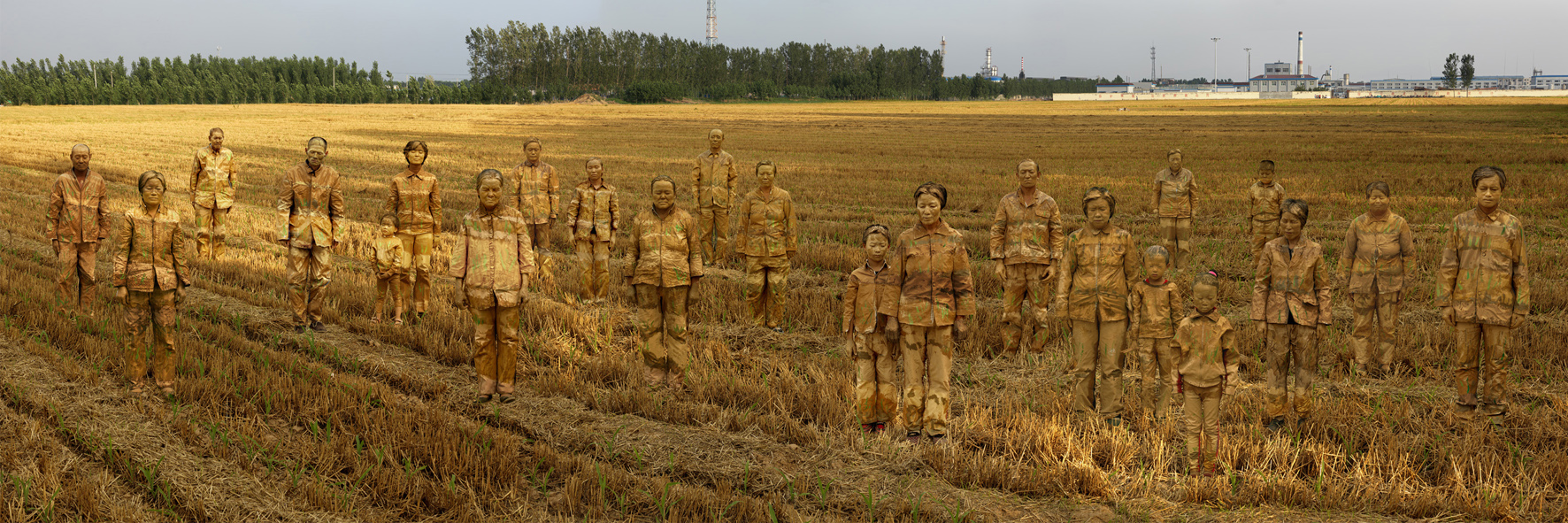Liu Bolin (TED Talk: The invisible man) takes the artist statement to another level — by actually disappearing into what he wants to say. Bolin makes some rather bold statements about consumerism, mass culture — even the Chinese government — rather quietly, by creating and wearing suits that allow him to blend seamlessly into the background of his images. Below are 10 previously unpublished pieces from his series “Hiding in the City.” See if you can spot him in each one.

Bolin + Pollock
For this piece, Bolin concealed himself inside one of Jackson Pollock’s iconic paintings. “Pollock is a great artist. I like that the composition of his work is bold and unrestrained,” Bolin said in an interview with TED. “I hid in his work in order to pay tribute to the master and hope that I could gain some inspiration from his oeuvre.” Hiding in the City — Art No. 1, by Liu Bolin, 2013. Photograph courtesy Klein Sun Gallery, New York.

Invisible in the streets of Beijing
From American abstract expressionism to Chinese street art. Hiding in the City — Beijing Graffiti No. 1, by Liu Bolin, 2012. Photograph courtesy Klein Sun Gallery, New York.

Reality as suppression of creativity
Says Bolin of his decision to conceal himself in the background of his images: “The real world seems more like an imprisonment of the creativity of the human race.” Hiding in the City — Balloon, by Liu Bolin, 2012. Photograph courtesy Klein Sun Gallery, New York.

How to spend hours fading into the background
If a background is simple, Bolin will stand still for three to four hours while the picture is taken. More complex backgrounds can take up to four days to prepare. Hiding in the City — Info Wall, by Liu Bolin, 2011. Photograph courtesy Klein Sun Gallery, New York.

Hiding to raise awareness
In 2013, Bolin began to include other people in his images. He took this picture in a village in rural China whose residents had been deeply impacted by a nearby chemical plant. “Every night, the chemical plant emitted noxious gas. The local crops became inedible. The local groundwater became seriously polluted. Natural mortality rate doubled,” he says; he pays tribute to some of the survivors here. Hiding in the City — Cancer Village, by Liu Bolin, 2013. Photograph courtesy Klein Sun Gallery, New York.

What you can see by being invisible
“By making myself invisible, I try to explore and question the contradictory and often inter-canceling relationship between our civilization and its development,” Bolin said in his 2013 TED Talk. Hiding in the City — Door God No. 1, by Liu Bolin, 2013. Photograph courtesy Klein Sun Gallery, New York.

What’s really in your soft drink?
Bolin’s work is often concerned with food safety, an issue that has cropped up in a big way in the past five years in China. “In 2011, Plasticizer was found to be added into soft drinks,” says Bolin. “I did a piece about that, and from then on, all kinds of food safety affairs were exposed.” Hiding in the City — Puffed Food, by Liu Bolin, 2011. Photograph courtesy Klein Sun Gallery, New York.

Silent commentary on China
Much of Bolin’s work is a silent commentary on modern sociopolitical conditions within his native China. Hiding in the City — Eating House, by Liu Bolin, 2011. Photograph courtesy Klein Sun Gallery, New York.

What holds us back?
“I wanted to express confusions of mine about some of the problems that have restrained the development of the human race, that human beings who live in this time have to face,” says Bolin, hiding here in a mural of Chairman Mao. Hiding in the City — Head portrait, by Liu Bolin, 2012. Photograph courtesy Klein Sun Gallery, New York.

Art born of thought and struggle
“If an artwork is to touch someone, it must be the result of not only technique, but also the artist’s thinking and struggle in life,” Bolin said in his 2013 TED Talk. “The repeated struggles in life create artwork, no matter in what form.” Hiding in the City — Push Dozer, by Liu Bolin, 2011. Photograph courtesy Klein Sun Gallery, New York.
All photographs courtesy of the Klein Sun Gallery, NYC.













